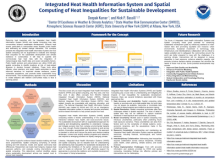Integrated Heat Health Information System and Spatial Computing of heat inequalities for Sustainable Development
Deepak
Kumar
University at Albany (UAlbany), State University of New York (SUNY), Center of Excellence in Weather & Climate Analytics, Atmospheric Sciences Research Center (ASRC), Albany-12226, New York,
Poster
Reducing heat inequities with the Integrated Heat Health Information System (NIHHIS) and spatial computing has helped communities achieve sustainable development. Extreme heat events, particularly in metropolitan areas, threaten public health and well-being as climate change intensifies. This abstract describes the Integrated Heat Health Information System and how spatial computing can evaluate and manage heat inequities to promote sustainable development and climate resilience in communities. To quantify and communicate high heat risks, the Integrated Heat Health Information System (NIHHIS) incorporates meteorological data, health data, and social vulnerability factors. Public health workers and policymakers can utilize NIHHIS to identify locations at risk of heat-related illnesses and develop focused initiatives to protect them. This method aids evidence-based decision-making and heat wave preparedness. Spatial computing, including GIS and remote sensing, can observe, model, and explain community heat differences. Researchers can locate heat hotspots, measure heat exposure patterns, and evaluate cooling interventions using spatial computing. This data-driven method identifies places where sustainable development actions are needed most to reduce heat inequities. In sustainable development, NIHHIS and spatial computing enable a holistic understanding of the complicated interaction between heat, health, and socio-economic issues. Policymakers can improve public health and climate resilience in vulnerable communities by understanding these links. To reduce the urban heat island effect and improve community well-being, green infrastructure initiatives including urban blue-green spaces, cool roofs, and energy-efficient buildings can be carefully deployed. Community engagement and participation are also crucial to sustainable development. Residents can prepare for heat events with the NIHHIS and spatial computing tools. Social cohesion, social support, and fair cooling resource access can be promoted through community-based programs. Spatial computing and the Integrated Heat Health Information System (NIHHIS) can transform community heat inequities and sustainable development. These tools allow politicians, urban planners, and public health authorities to make informed decisions to improve climate resilience, protect vulnerable populations, and promote better and more sustainable living environments for all. This multidisciplinary approach is essential to create adaptive and resilient communities ready to face a warming planet.

Poster file
deepak-kumar-blocking-poster.pdf
(459.79 KB)
Meeting homepage
